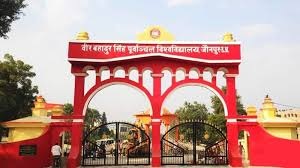VBSPU PUCAT Syllabus Purvanchal University Combined Admission Test
Organisation : Veer Bahadur Singh Purvanchal University Jaunpur VBSPU
Exam Name : Purvanchal University Combined Admission Test (PUCAT-2024)
Announcement : Syllabus
Website : http://www.vbspu.ac.in/en/page/vbspu-admission
VBSPU Syllabus For PUCAT
CHEMISTRY :
Some Basic Concepts of Chemistry: General Introduction: Importance and scope of Chemistry. Atomic and molecular masses, mole concept and molar mass, percentage composition, empirical and molecular formula, chemical reactions, stoichiometry and calculations based on stoichiometry.
Related / Similar Syllabus : J&K BOPEE Syllabus Common Entrance Test CET B.Sc. Nursing /Para-Medical Courses

Structure of Atom: Bohr’s model and its limitations, concept of shells and subshells, dual nature of matter and light, de Broglie’s relationship, Heisenberg uncertainty principle, concept of orbitals, quantum numbers, shapes of s, p and d orbitals, rules for filling electrons in orbitals – Aufbau principle, Pauli’s exclusion principle and Hund’s rule, electronic configuration of atoms, stability of half-filled and completely filled orbitals.
Classification of Elements and Periodicity in Properties: Modern periodic law and the present form of periodic table, periodic trends in properties of elements – atomic radii, ionic radii, inert gas radii, Ionization enthalpy, electron gain enthalpy, electronegativity, valency. Nomenclature of elements with atomic number greater than 100.
Chemical Bonding and Molecular Structure: Valence electrons, ionic bond, covalent bond, bond parameters, Lewis structure, polar character of covalent bond, covalent character of ionic bond, valence bond theory, resonance, geometry of covalent molecules, VSEPR theory, concept of hybridization involving s, p and d orbitals and shapes of some simple molecules, molecular orbital theory of homonuclear diatomic molecules (qualitative idea only), Hydrogen bond.
Redox Reactions: Concept of oxidation and reduction, redox reactions, oxidation number, balancing redox reactions – in terms of loss and gain of electrons and change in oxidation number. Hydrogen: Position of hydrogen in periodic table, occurrence, isotopes, hydridesionic, covalent and interstitial; physical and chemical properties of water, heavy water, hydrogen as a fuel.
Organic Chemistry: Some basic Principles and Techniques: General introduction, classification and IUPAC nomenclature of organic compounds. Electronic displacements in a covalent bond: inductive effect, electromeric effect, resonance and hyper conjugation. Homolytic and heterolytic fission of a covalent bond: free radicals, carbocations, carbanions, electrophiles and nucleophiles, types of organic reactions.
States of Matter: Gases and Liquids: Three states of matter, intermolecular interactions, types of bonding, melting and boiling points, role of gas laws in elucidating the concept of the molecule, Boyle’s law, Charles law, Gay Lussac’s law, Avogadro’s law, ideal behaviour, empirical derivation of gas equation, Avogadro’s number, ideal gas equation and deviation from ideal behaviour.
Chemical Thermodynamics: Concepts of System and types of systems, surroundings, work, heat, energy, extensive and intensive properties, state functions. First law of thermodynamics – internal energy and enthalpy, measurement of U and H, Hess’s law of constant heat summation, enthalpy of bond dissociation, combustion, formation, atomization, sublimation, phase transition, ionization, solution and dilution. Second law of Thermodynamics (brief introduction) Introduction of entropy as a state function, Gibb’s energy change for spontaneous and non- spontaneous processes. Third law of thermodynamics (brief introduction).
Equilibrium: Equilibrium in physical and chemical processes, dynamic nature of equilibrium, law of mass action, equilibrium constant, factors affecting equilibrium – Le Chatelier’s principle, ionic equilibrium- ionization of acids and bases, strong and weak electrolytes, degree of ionization, ionization of poly basic acids, acid strength, concept of pH, buffer solution, solubility product, common ion effect (with illustrative examples).
s -Block Elements: Group 1 and Group 2 Elements -General introduction, electronic configuration, occurrence, anomalous properties of the first element of each group, diagonal relationship, trends in the variation of properties (such as ionization enthalpy, atomic and ionic radii), trends in chemical reactivity with oxygen, water, hydrogen and halogens, uses.
Some p -Block Elements: General Introduction to p -Block Elements Group 13 Elements: General introduction, electronic configuration, occurrence, variation of properties, oxidation states, trends in chemical reactivity, anomalous properties of first element of the group, Boron – physical and chemical properties. Group 14 Elements: General introduction, electronic configuration, occurrence, variation of properties, oxidation states, trends in chemical reactivity, anomalous behaviour of first elements. Carbon – catenation, allotropic forms, physical and chemical properties.
Hydrocarbons: Classification of Hydrocarbons Aliphatic Hydrocarbons: Alkanes – Nomenclature, isomerism, conformation (ethane only), physical properties, chemical reactions. Alkenes – Nomenclature, structure of double bond (Ethene), geometrical isomerism, physical properties, methods of preparation, chemical reactions:- addition of Hydrogen, Halogen, water, hydrogen halides (Markovnikov’s addition and peroxide effect), Ozonolysis, Oxidation, mechanism of electrophilic addition. Alkynes – Nomenclature, structure of triple bond (Ethyne), physical properties, methods of preparation, chemical reactions: acidic character of alkynes, addition reaction of – hydrogen, halogens, hydrogen halides and water.
Aromatic Hydrocarbons: Introduction, IUPAC nomenclature, benzene: resonance, aromaticity, chemical properties: mechanism of electrophilic substitution. Nitration, sulphonation, halogenation, Friedel Craft’s alkylation and acylation, directive influence of functional group in monosubstituted benzene. Carcinogenicity and toxicity.
Solid State: Classification of solids based on different binding forces: molecular, ionic, covalent and metallic solids, amorphous and crystalline solids (elementary idea). Unit cell in two dimensional and three-dimensional lattices, calculation of density of unit cell, packing in solids, packing efficiency, voids, number of atoms per unit cell in a cubic unit cell, point defects.
Solutions: Types of solutions, expression of concentration of solutions of solids in liquids, solubility of gases in liquids, solid solutions, Raoult’s law, colligative properties- relative lowering of vapour pressure, elevation of boiling point, depression of freezing point, osmotic pressure, determination of molecular masses using colligative properties.
Question Paper Pattern
For Bachelor of Science (B. Sc.)
For Admission to: B. Sc. (Zoology, Botany, Chemistry, Environmental Science, Physics, Maths, Chemistry, Geology, Microbiology), B. Sc. (Hons.) Biotechnology, B.Sc. (Hons.) Environmental Science.
** All Parts are Compulsory
Time: 02 Hours
Total MCQs : 100
Physics – 30
Chemistry – 30
Mathematics/Biology – 40

Download PUCAT Syllabus
Syllabus For PUCAT 2024 here : https://www.syllabus.gen.in/uploads/pdf2024/3363-pu.pdf